News
News from Nepal. Amanda posted: What? Twin Earthquakes!
From FrugalTravelsNepal
Yesterday, May 12, 2015 another major earthquake came, 7.3-4. There was another epicenter so I guess it means it’s a brand new earthquake. No more people died in our village, but 6 Americans died from an Osprey accident and 2 Nepali.On a side note, I was living in the town in Florida that had twin hurricanes in 2004. Who knew there were twin earthquakes.
We were home, Bimila, Mark, our new helpx volunteer, Sajana, my new helper and me. It hit hard, not like the wave I’d felt during the first one. And we panicked. We jumped up and went down the stairs while it shook the entire time. “Bimila,” I called out as we went down the stairs and she promptly joined us going down the stairs. Although I know we should not leave the building, we all promptly ran outside and to the hilltop. Bimila had been traumatized enough from the first earthquake while she clung to our tourist guest as she watched the devastation happening in Bhhaktapur.
As we reached the hilltop I turned to see our housecleaner, didi, coming out! She had been on the roof doing laundry. I gave her a big hug to try to ground her. I sat with her for a few minutes and then turned to look for Bimila. I jumped up and told our didi that I was going to look for her and as I got a ways up the hill I heard her call me. I thought she went to look for her father, Kamal, who was up near the temple doing some thangka painting.
I waited for her to come and even without a word we turned to find him and almost ran past the old buildings as we past. Bimila wouldn’t let go of me. We stopped along the way when we saw people we knew to ask. I knew Kamal is the kind of person who will stop to help his neighbor and that can be deadly at such times as this.
Sure enough, Kamal had stopped what he was working on when a tourist asked for directions to Nagarkot. He had been safely out of harm’s way when the earthquake struck. His random act of kindness hadn’t saved his life, but likely saved him from the initial trauma.
We spent the night at the hilltop. Fortunately, Mark had brought tarps, so we made a nice tent. He has been working so hard to help clear debris in the village so some shops could possibly open again.Tonight we will use Mark’s mosquito net, which will make it a lot better. The mosquitoes buzzed around all night except for when the wind picked up. I put coconut oil on my face to keep them away. They cannot take an oil base like that and will die if they land.
About the guest house: Star View held up quite well during the first couple quakes and aftershocks, but after this earthquake I noticed more paint on the floor and the cracks are growing. None of the baring walls seem to be compromised, but the wall I’m most concerned about is near the door. Sleeping in the room would be foolish, and upstairs might be even worse prior to getting a qualified inspector. I’ve been promised that ‘someone might come today.’
The electric has been cut to the guest house due to some of the homes on the grid have fallen. After the inspection we will get a generator, but if it’s not safe to stay here I plan to let my inner American come out and I’ll stay at a friend’s guest house that stayed intact in Nagarkot. Many of the guest houses in Nagarkot collapsed, but Hotel Mt. Paradise is only two story and almost as new as mine.
65 people are said to have died yesterday in this new earthquake.
Even with the earthquakes and craziness, I am so happy here and there is nowhere I’d rather be than in Nepal. I saw this bird this morning while having my coffee.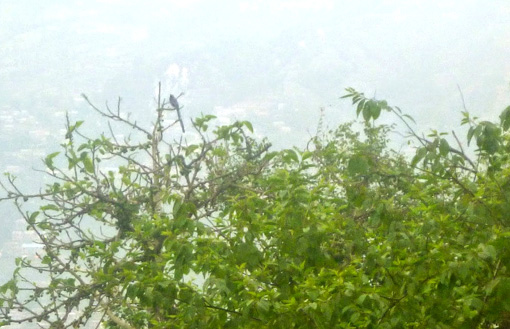
Posted by Amanda Summers at 9:30 PM
Another Powerful Earthquake Hits Nepal
A major earthquake has struck eastern Nepal, two weeks after more than 8,000 people were killed in a devastating quake.
It had a magnitude of 7.3 and struck near Mount Everest, in the town of Namche Bazaar 68 kilometers away from Mount Everest.
This is the live feed from Reuters.
Soon we’ll provide updates from our village.
Thanks for your support.
AP Article: Earthquake Aid Still Scarce In Nepal’s Remote Villages As Anger Grows
PAUWATHOK, Nepal (AP) — At the entrance of this destroyed mountain village, a wooden sign stands, cobbled together from debris of homes flattened by Nepal’s devastating earthquake. Its message: “WE NEED HELP. PLEASE HELP.”
A steep winding road leads up to the ruins of the small village of Pauwathok, perched on a ridge about 3,600 feet (1,100 meters) above sea level. It’s just 30 miles (50 kilometers) east of Kathmandu, Nepal’s capital. But villagers say not one government official, not one soldier has visited since the massive quake struck a week ago, underscoring just how unprepared and overwhelmed Nepal’s government has been.
Early Saturday, a convoy of covered trucks approached Pauwathok. The trucks were apparently transporting aid and escorted by Nepalese police carrying automatic weapons. Hungry residents ran toward the road.
The trucks were not stopping.
“Are we invisible to you?!” a voice among the crowd screamed as the trucks rode slowly up a hill and out of sight.
One week after the strongest tremor to hit impoverished Nepal in eight decades, aid has been slow in reaching those who need it most. In many places it has not come at all.
U.N. humanitarian officials said Saturday they are increasingly worried about the spread of disease. They said more helicopters are needed to reach isolated mountain villages like Pauwathok, which were hard to access even before the quake.
The true extent of the damage from the magnitude-7.8 earthquake is still unknown as reports keep filtering in from remote areas, some of which remain entirely cut off. The U.N. has estimated the quake affected 8.1 million people — more than a quarter of Nepal’s 28 million people.
The government’s latest number, reported Sunday, is 7,040 dead, with little hope of finding survivors.
Nepal has been shaken by more than 70 aftershocks, and its people remain on edge. One brief aftershock Sunday afternoon shook this village’s only paved road, triggering screams from residents who began to run, then stopped when the tremor eased.
Pauwathok is located in the district of Sindupalchok, where more deaths have been recorded than anywhere else in Nepal — 2,560, compared to 1,622 in Kathmandu. The U.N. says up to 90 percent of the houses in Sindupalchok have been destroyed.
Rajaram Giri said he was sitting under a large tree when the big quake hit April 25. Pauwakthok was immediately engulfed in clouds of red dust. When it cleared, Giri saw only ruins.
Only a handful of the village’s roughly 80 homes remain habitable. Mostly made of brick and mud and sticks, they were either completely leveled or damaged beyond repair. Some families now sleep under makeshift shelters of debris that they constructed from their own ruined homes — torn roofs and boards, whatever was left.
Others sleep under tarpaulins — obtained only after residents sat in the middle of the road Friday and blocked an aid convoy that eventually relinquished 30 of them, said Giri, who took one for his family.
“We only have the clothes on our backs,” he said. “The rest has been buried under the rubble.”
Volunteers have begun stepping into the void. Late Saturday, Pauwathok’s appeal for help was finally answered.
A truck full of rice, noodles and medical supplies pulled up. Everyone crowded round.
The truck had been organized by a teacher who went for help to Kathmandu, where he collected donations from charities and friends. They brought the aid themselves.
“The government has not been able to cater to the needs of everyone, so it’s better if everybody can pitch in,” said Supral Raj Joshi, who helped bring the aid. “It’s not that the government isn’t trying, it’s that they’ve not been able to reach everywhere.”
Six other civilians, several of whom worked with street kids in Kathmandu, also came to deliver medical aid Saturday.
They dressed the wound of an elderly lady, Tilamaya Bharti, who had lost part of a finger when a stone crushed it during the tremor. They also gave Bharti painkillers — the first she’d had since doctors in a nearby town conducted a hasty amputation last week and sent her away with nothing to ease the pain.
While the situation in Pauwathok is grave, some remote parts of Nepal appear to have suffered even more.
David O’Neill of U.K. International Search and Rescue said a team from his group had driven as far as it could, then walked for hours into six remote villages to assess them. The team reported that the villages had been so badly hit, 80 percent of their inhabitants had died.
“Everything has been flattened,” O’Neill said. The people there apparently died not in the original quake, but in a major aftershock the next day, he said.
O’Neill spoke in Chautara, a destroyed town in Sindhupalchok. His team had hoped to reach the remote areas by helicopter, but none were available, so they were returning to Kathmandu.
“We definitely need more helicopters,” Ertharin Cousin, executive director of the U.N.’s World Food Program, told The Associated Press in the village of Majuwa, west of the capital. Aid agencies have been using Majuwa as a staging ground to get supplies deeper into mountainous areas.
“This is one of the poorest places on Earth,” Cousin said. “If the global community walks away, the people of this country will not receive the assistance that is required for them to rebuild their lives.”
That need remains great. Nepal Information Minister Minendra Rijal said the government has supplied only 29,000 tents to 400,000 displaced people.
“The earthquake has caused unimaginable destruction,” said Rownak Khan, a U.N. Children’s Fund senior official in Nepal. “Hospitals are overflowing, water is scarce, bodies are still buried under the rubble and people are still sleeping in the open. This is a perfect breeding ground for disease.”
Medicine, medical equipment, tents and water supplies are needed now, he said.
“We have a small window of time to put in place measures that will keep earthquake-affected children safe from infectious disease outbreaks – a danger that would be exacerbated by the wet and muddy conditions brought on with the rains,” Khan said.
Laxi Dhakal, a Nepal Home Ministry official, said hopes of finding survivors had faded. “Unless they were caught in an air pocket, there is not much possibility,” he said.
In Jalkeni, a village not far from Pauwathok, the road is lined with mounds of broken wood and stone, the remains of destroyed homes.
On top of one mound sat a woman cradling a young girl. The mound — surrounded by a pile of dusty rocks, a broken TV and shredded clothes — used to be Sunita Shrestha’s two-story home.
“No one has come to help us yet,” said Shrestha, as the sun beat down. “I don’t know if they ever will.”
___
Associated Press writers Binaj Gurubacharya in Kathmandu and Katy Daigle in Majuwa, Nepal, contributed to this report.
Nepal Earthquake updates & news
Updates May 1 2015
GOOD NEWS FROM AMANDA AND KAMAL.
THE FAMILY OF TRADITIONAL ART OF NEPAL IS SAFE.
THE VILLAGE OF CHANGU AND OUR WORKSHOPS WERE SEVERELY DAMAGED OR DESTROYED BUT LIFE GOES ON.
THE VILLAGE OF CHANGU NARAYAN WAS STRONGLY HIT BY THE EARTHQUAKE OF 7.9 THAT HIT NEPAL AND NORTH OF INDIA.
ONLY TWO PEOPLE DIED in Changu, SADLY ONE OF THEM WAS A 5 YEARS OLD CHILDREN.
The city/village of Bhaktapur was almost destroyed.
This is a video from an Italian tourist in the main center of one of the most amazing temples and historical site in the world.
—————–
Dear customers and friends from all around world,
I am the webmaster of traditionalArtOfNepal.com in collaboration with Kamal and Amanda.
I am in north of India at this time and I do also felt the quake.
I’m trying to get in touch with Kamal and Amanda in Changu Narayan and other friends in Bhaktapur and other villages in Nepal.
I’ll update the blog with news as soon as possible.
Sorry for the inconvenience and the delay with our current orders.
A pray for all people suffering in Nepal and North of India.
Blessing
traditionalartofnepal.com
Nepal earthquake: International aid effort increased
How To Order
- Browse our catalog and choose your favorite design.
- Select your preferred size and quality to check the price.
- Click on “Product Inquiry” to send us a message and we will check if we the artwork is immediately available. If not we will make it for you.
- Use the cart page to calculate the shipping cost by selecting your country.
- Once we receive your order we will start creating the artwork according to your preferences and provide you with updates and images upon your request.
We strive to ensure a smooth shopping experience with our assistance. We also welcome commissions of custom designs of thangkas, masks and mandalas.
Shipping and Payments
We offer trusted shipping options to ensure your purchases arrive in perfect condition, and delivered in 5 to 10 working days worldwide. We accept PayPal, debit/credit cards and bank wire transfer services.
About Our Community
We live in Changunarayan, a UNESCO heritage site located on a forested hill overlooking Bhaktapur and the Kathmandu valley. You are welcome to visit our art school and meet our community of artists and artisans.
Learn More About Our Thangka School And Workshops
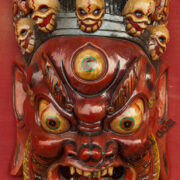 Red Mahakala Mask
Red Mahakala Mask 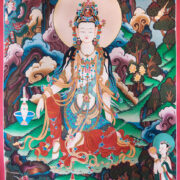 Quan Yin Thangka
Quan Yin Thangka 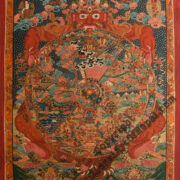 Wheel of Life 2
Wheel of Life 2 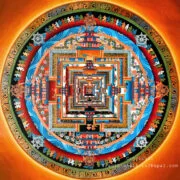 Kalachakra Mandala
Kalachakra Mandala 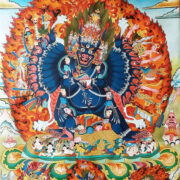 Vajrabhairava
Vajrabhairava 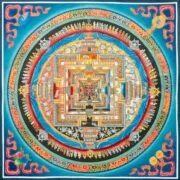 Kalachakra Mandala Auspicious Symbols
Kalachakra Mandala Auspicious Symbols 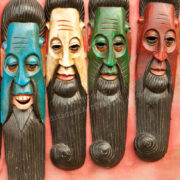 Sadhu Baba Masks
Sadhu Baba Masks 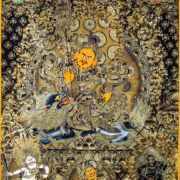 Five Jambhala Thangka
Five Jambhala Thangka 